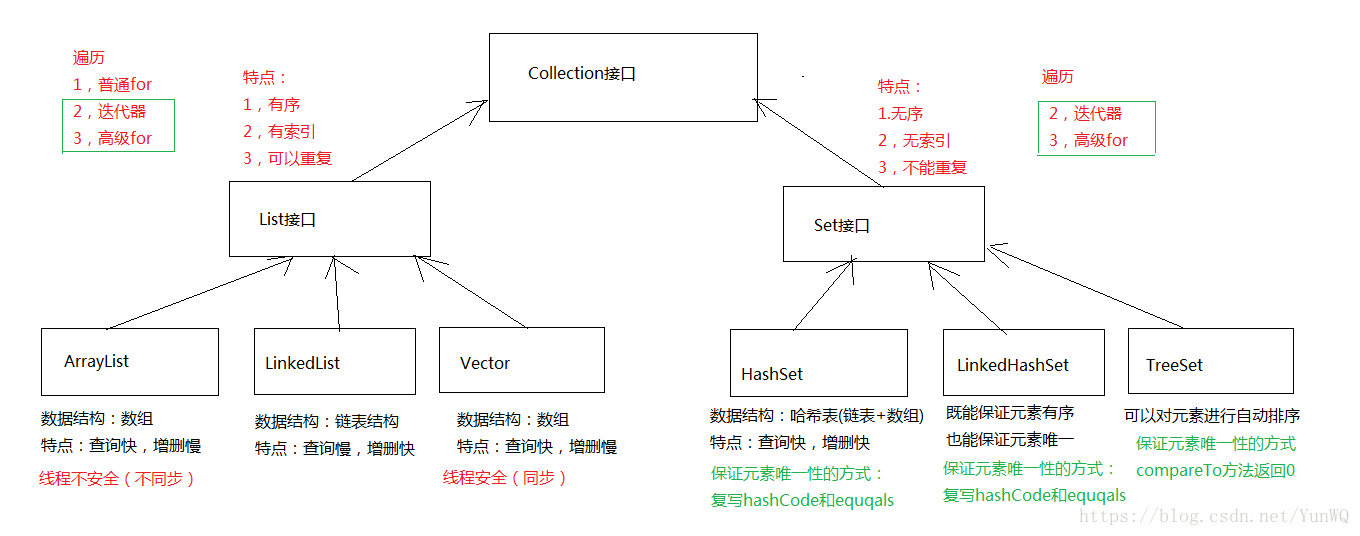本文最后更新于:2024年4月16日 下午
一、Collection接口 Collection接口分别有List、Set两个子接口,根据具体实现采用的结构不同又分为ArrayList、LinkedList等
1.Collection的常用功能 1 2 3 4 5 6 7 8 9 10 11 12 13 14 15 16 17 18 19 1. 添加功能boolean add (E e) boolean addAll (Collection c) 2. 删除功能boolean remove (Object o) 3. 判断功能boolean contains (Object o) boolean isEmpty () 4. 获取功能int size () 5. 转换功能
2.遍历集合的方式 普通的for循环,需要索引,对数组支持的集合操作更方便
1 2 3 4 5 6 7 8 9 10 11 12 13 14 import java.util.*;public class test {public static void main (String[] args) {new ArrayList <String>();"Hello" );"Java" );"World" );for (int i = 0 ; i < list.size(); i++){String s = (String) list.get(i);
迭代器遍历,可以遍历任何集合,与传统的迭代器(例如C++标准模板库的迭代器)不同
C++ STL中迭代器是根据数组索引建模的,给定迭代器可以查看指定位置上的元素,就像知道索引 i 可以查看数组a[i]一样,不需要查找元素就可以将迭代器前移
Java迭代器的查找操作和位置变更是紧密相连的,查找一个元素唯一的方法是调用next,执行查找操作的同时迭代器位置前移
1 2 3 4 5 6 7 8 9 10 11 12 13 14 15 16 17 18 import java.util.*;public class test {public static void main (String[] args) {new ArrayList <String>();"Hello" );"Java" );"World" );while (it.hasNext()){String s = it.next();
for-each循环 :用更简洁的方式表达同样的操作。编译器将for each循环翻译为带有迭代器的循环
1 2 3 4 5 6 7 8 9 10 11 12 13 14 15 16 17 18 19 20 import java.util.*;public class test {public static void main (String[] args) {new ArrayList <String>();"Hello" );"Java" );"World" );for (String s : c){int [] arr = {1 , 2 , 3 , 4 , 5 };for (int a : arr){
二、List集合 List集合包含List接口及其实现类。List集合有以下特点:
集合元素允许重复
集合元素有序
元素可以通过索引访问
常用的实现类有:ArrayList、LinkedList、Vector。
1.ArrayList ArrayList是List接口的典型实现类,本质上,ArrayList是对象引用的一个变长数组。
ArrayList是List接口的可变数组的实现。实现了所有可选列表操作,并允许包括null在内的所有元素。除了实现List接口外,此类还提供了一些方法来操作内部用来存储列表的数组的大小。
每个ArrayList实例都有一个初始容量,该容量用来储存列表元素的数组大小。默认初始容量为10。
ArrayList底层采用数组实现,因此它的优点是适合随机查找和遍历,缺点是不适合插入和删除。
注:Arrays.asList(…) 方法返回的 List 集合既不是 ArrayList 实例,也不是 Vector 实例。 Arrays.asList(…)返回值是一个固定长度的 List 集合。
1.1 添加元素 使用ArrayList添加元素有如下方法
set(int index, E element):替换数组中已经存在的元素内容。
add(E e):将元素添加到集合的末尾
add(int index, E element):将元素添加到指定的索引位置
addAll(Collection<? extends E> c):按照指定Collection的迭代器所返回的元素顺序,将该Collection中的所有元素添加到此列表的尾部。
addAll(inr index, Collection<? extends E> c):从指定的位置开始,将指定collection中的所有元素插入到此列表中
1 2 3 4 5 6 7 8 9 10 11 12 List<String> platformList = new ArrayList <>();"靓仔" );"你好" );"leslie" );"cheung" );"你好" );"靓仔" );3 , "个人博客" );
1.2 获取元素 获取ArrayList中指定索引处的元素的使用方法 get():获取指定位置上的元素
1 System.out.println("索引为3的元素为:" + myList.get(3 ));
如果指定的索引超出了集合的最大索引,比如myList.get(10010)就会抛出异常java.lang.IndexOutOfBoundsException:
1.3 获取集合元素个数 获取ArrayList元素个数的使用方法如下所示:
1 System.out.println("myList的元素个数为:" + myList.size());
1.4 删除元素 使用ArrayList删除元素有以下两个重载:
1 2 3 E remove (int index) ;boolean remove (Object o) ;
E remove(int index);是删除集合中指定索引处的元素,boolean remove(Object o);是删除集合中的指定元素。
使用方法如下所示:
1 2 3 4 5 4 );4 );"靓仔" );
1.5 修改元素 修改ArrayList中指定索引处的元素值的使用方法如下所示:
1 2 3 myList.set(0 , "salute" );1 , "LiuYi" );2 , "Bob Dylan" );
1.6 判断集合是否为空 判断ArrayList是否为空的使用方法如下所示:
1 System.out.println("isEmpty:" + myList.isEmpty());
1.7 清空集合 清空ArrayList中所有元素的使用方法如下所示:
小结 :
ArrayLlist内部是由数组来实现的。在存放数据的数组长度不够时,会进行扩容,即增加数组长度。扩展为原来的1.5倍。
由于是数组来实现,所以,优点是查找元素很快。可以通过下标查找元素,查找效率高。缺点是每次添加和删除元素都会进行大量的数组元素移动。长度不够会扩容。效率底下。
ArrayList每次的增、删、改操作都伴随着数组的复制和元素的移动。这意味着新的内存空间的开辟。
2.LinkedList LinkedList也是List接口的实现类,内部使用链表结构存储数据
分配内存空间不是必须是连续的;
插入、删除操作很快,只要修改前后指针就OK了,时间复杂度为O(1);
访问比较慢,必须得从第一个元素开始遍历,时间复杂度为O(n);
LinkedList类的代码声明如下所示:
1 2 3 4 5 public class LinkedList <E>extends AbstractSequentialList <E>implements List <E>, Deque<E>, Cloneable, java.io.Serializable{
LinkedList类的使用方法和ArrayList基本一样,只需修改下声明处的代码即可:
1 List<String> platformList = new LinkedList <>();
2.1 push、pop、poll
void push(E e):与addFirst一样,实际上它就是addFirst;
E pop():与removeFirst一样,实际上它就是removeFirst;
E poll():查询并移除第一个元素;
1 2 3 4 5 6 7 8 9 10 11 12 13 14 15 16 17 18 19 20 21 22 23 24 import java.util.*;public class test {public static void main (String[] args) {new LinkedList <>();"first" );"second" );"second" );"third" );"four" );"five" );"pop: " + linkedList.pop());"after pop: " + linkedList);"poll: " + linkedList.poll());"after poll: " + linkedList);
push、pop的操作很接近stack的操作。
在链表为空时,poll与pop的区别:
1 2 3 4 5 6 7 8 9 10 11 12 import java.util.*;public class test {public static void main (String[] args) {new LinkedList <>();"pop: " + linkedList.poll());"poll: " + linkedList.pop());
2.2 peek 获取元素,可以指定第一个peekFirst,也可以时最后一个peekLast,只能获取不会移除
1 2 3 4 5 6 7 8 9 10 11 12 13 14 15 16 17 18 19 20 21 22 23 24 25 26 27 28 29 30 31 import java.util.*;public class test {public static void main (String[] args) {new LinkedList <>();"first" );"second" );"second" );"third" );"four" );"five" );"linkedList: " + linkedList);"peek: " + linkedList.peek());"peekFirst: " + linkedList.peekFirst());"peekLast: " + linkedList.peekLast());"linkedList: " + linkedList);new LinkedList <>();"linkedList2: " + linkedList2);"peek: " + linkedList2.peek());"peekFirst: " + linkedList2.peekFirst());"peekLast: " + linkedList2.peekLast());
2.3 offer
boolean offer(E e):在链表尾部插入一个元素;
boolean offerFirst(E e):与addFirst一样,实际上它就是addFirst;
boolean offerLast(E e):与addLast一样,实际上它就是addLast;
1 2 3 4 5 6 7 8 9 10 11 12 13 14 15 16 17 18 19 20 21 22 23 24 25 import java.util.*;public class test {public static void main (String[] args) {new LinkedList <>();"first" );"second" );"second" );"third" );"four" );"five" );"linkedList: " + linkedList);"six" );"linkedList: " + linkedList);"zero" );"linkedList: " + linkedList);"seven" );"linkedList: " + linkedList);
3.Vector Vector也是List接口的实现类,内部也是通过数组来实现。
java.util.vector提供了向量类(Vector)以实现类似动态数组的功能。
对于预先不知或者不愿预先定义数组大小,并且需要频繁地进行查找,插入,删除工作的情况,可以考虑使用向量类。
向量类提供了三种构造方法:
1 2 3 public vector () public vector (int initialcapacity,int capacityIncrement) public vector (int initialcapacity)
使用第一种方法系统会自动对向量进行管理,若使用后两种方法,则系统将根据参数,initialcapacity设定向量对象的容量(即向量对象可存储数据的大小),当真正存放的数据个数超过容量时。系统会扩充向量对象存储容量。
参数capacityincrement给定了每次扩充的扩充值。当capacityincrement为0的时候,则每次扩充一倍,利用这个功能可以优化存储。
Vector类的代码声明如下所示:
1 2 3 4 public class Vector <E> extends AbstractList <E>implements List <E>, RandomAccess, Cloneable, java.io.Serializable{
与ArrayList不同的是,Vector是线程安全的 ,即某一时刻只有一个线程能够写Vector,避免多线程同时写而引起的不一致性。不过这也造成Vector的缺点:实现线程的同步需要额外的花费,因此它的访问速度会比ArrayList慢一些。
可以认为Vector是ArrayList在多线程环境下的实现版本。所以Vector类的使用方法和ArrayList基本一样,只需修改下声明处的代码即可:
1 List<String> platformList = new Vector <>();
由于要支持线程同步,因此Vector类的很多方法都有synchronized关键字,如下所示:
1 2 3 4 5 6 7 8 9 10 11 12 13 public synchronized boolean isEmpty () {return elementCount = = 0 ;public synchronized int size () {return elementCount;public synchronized void addElement (E obj) {1 );
三、ArrayList、LinkedList、Vector区别 1 底层实现 ArrayList和Vector是基于数组实现的,LinkedList是基于双向链表实现的。
这也就导致ArrayList适合随机查找和遍历,而LinkedList适合动态插入和删除元素。
2 线程安全性 ArrayList和LinkedList是线程不安全的,Vector是线程安全的。
Vector可以看做是ArrayList在多线程环境下的另一种实现方式,这也导致了Vector的效率没有ArraykList和LinkedList高。
如果要在并发环境下使用ArrayList或者LinkedList,可以调用Collections类的synchronizedList()方法:
1 Collections.synchronizedList(myList);
3 扩容机制 ArrayList和Vector都是使用Object类型的数组(Object[ ] array)来存储数据的,ArrayList的默认容量是10,Vector的默认容量是0。
当向这两种类型中添加元素时,若容量不够,就会进行扩容,扩容的本质是产生一个新数组,将原数组的数据复制到新数组,再将新的元素添加到新数组中,使用的方法是Arrays.copyOf(),其中ArrayList扩容后的容量是之前的1.5倍,Vector默认情况下扩容后的容量是之前的2倍 。
查看ArrayList的源码,就明白为什么会这样扩容:
1 2 3 4 5 6 7 8 9 10 11 12 13 14 15 16 17 18 19 20 21 22 23 24 25 26 27 28 29 30 31 32 33 34 35 36 37 38 private static final int DEFAULT_CAPACITY = 10 ;public boolean add (E e) {1 ); return true ;private void ensureCapacityInternal (int minCapacity) {private static int calculateCapacity (Object[] elementData, int minCapacity) {if (elementData == DEFAULTCAPACITY_EMPTY_ELEMENTDATA) {return Math.max(DEFAULT_CAPACITY, minCapacity);return minCapacity;private void ensureExplicitCapacity (int minCapacity) {if (minCapacity - elementData.length > 0 )private void grow (int minCapacity) {int oldCapacity = elementData.length;int newCapacity = oldCapacity + (oldCapacity >> 1 );if (newCapacity - minCapacity < 0 )if (newCapacity - MAX_ARRAY_SIZE > 0 )
最核心的代码就是int newCapacity = oldCapacity + (oldCapacity >> 1);,所以ArrayList扩容后的容量是之前的1.5倍。
查看Vector的源码,就明白为什么会这样扩容:
1 2 3 4 5 6 7 8 9 10 11 12 13 14 15 16 17 18 19 20 21 22 23 24 public synchronized void addElement (E obj) {1 );private void ensureCapacityHelper (int minCapacity) {if (minCapacity - elementData.length > 0 )private static final int MAX_ARRAY_SIZE = Integer.MAX_VALUE - 8 ;private void grow (int minCapacity) {int oldCapacity = elementData.length;int newCapacity = oldCapacity + ((capacityIncrement > 0 ) ?if (newCapacity - minCapacity < 0 )if (newCapacity - MAX_ARRAY_SIZE > 0 )
最核心的代码就是int newCapacity = oldCapacity + ((capacityIncrement > 0) ?capacityIncrement : oldCapacity);,所以Vector默认情况下扩容后的容量是之前的2倍。
【参考】
